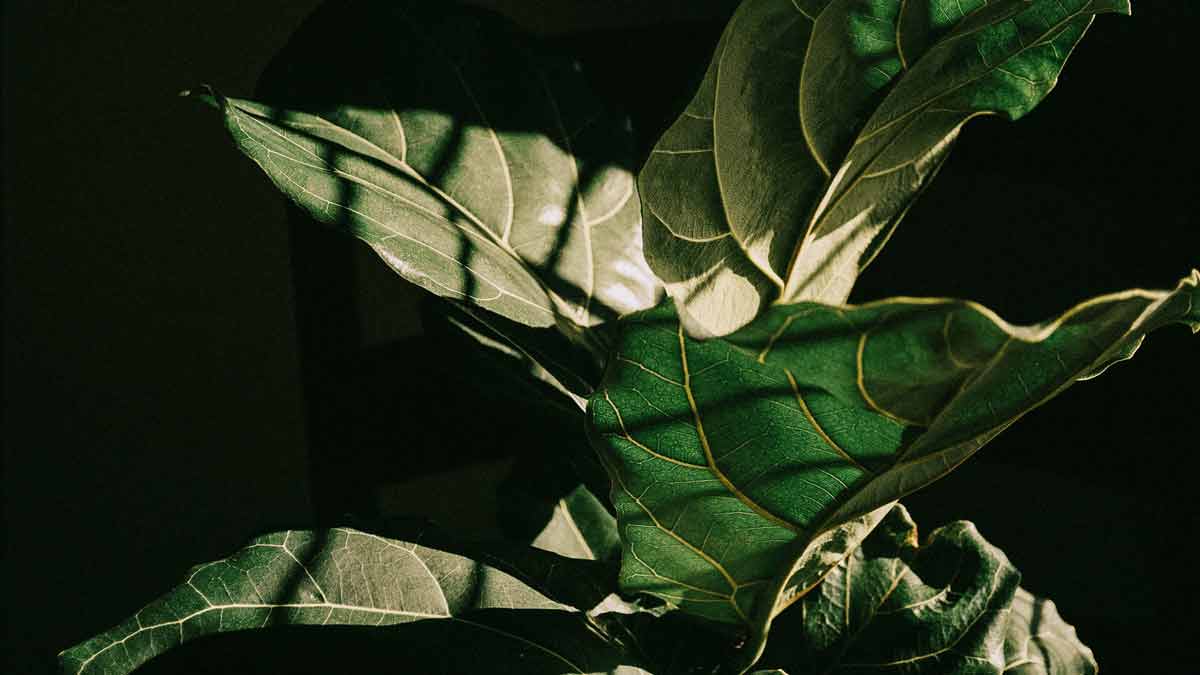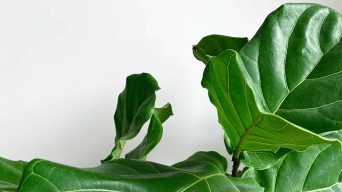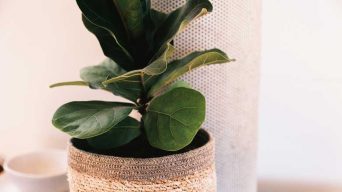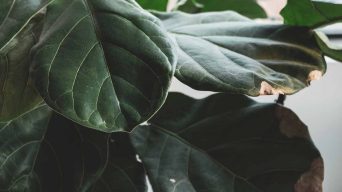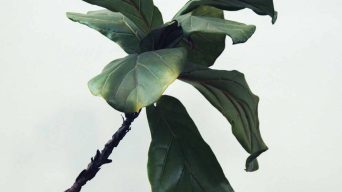You can take several steps to save a struggling or dying fiddle leaf fig tree. First, assess whether the plant receives proper sunlight, watering, and temperature conditions. You may need to adjust any of these factors if they are not optimal. Trimming off any brown edges on leaves can also help redirect energy towards healthy growth. Additionally, avoid transplanting until new growth is observed, and do not overwater.
Is your fiddle leaf fig tree showing signs of distress? Are you witnessing those once vibrant, velvety leaves starting to wilt and decay? Don’t sound the funeral bells just yet!
Fiddle leaf figs are resilient plants, capable of bouncing back from the brink with a few strategic steps.
Here, we’ll guide you through practical, effective tips to revive your dying Fiddle Leaf Fig and transform it back into the living room showstopper it was meant to be.
From troubleshooting common issues to providing your green companion with the perfect care regimen—if you’re on the verge of surrendering to plant parenthood, stick around, and let’s save that Fig together!
Facts and Statistics
- According to the American Society for Horticultural Science, overwatering is the leading cause of death in fiddle leaf figs, responsible for nearly 50% of reported cases.
- A 2022 study found that approximately 80% of indoor fiddle leaf fig trees show signs of distress within their first two years of care due to lack of appropriate sunlight exposure.
- In a survey conducted by ‘Houseplant Care Academy’, around 70% of people misjudge the watering needs of their fiddle leaf figs, often leading to root rot and stunted growth.
Diagnosing Symptoms of a Dying Fiddle Leaf Fig
If you’ve noticed your fiddle leaf fig plant looking less vibrant or experiencing a decline in its overall health, it’s essential to diagnose the symptoms accurately.
Identifying the underlying issues is the first step towards reviving your plant and saving it from an untimely demise. Let’s explore some key factors to consider when diagnosing a dying fiddle leaf fig.
One common symptom to observe is the appearance of brown spots on the leaves. This often indicates an issue with watering or humidity levels.
Conversely, yellowing leaves can suggest overwatering or even root rot. Additionally, droopy and wilted leaves can indicate both underwatering and overwatering, making it crucial to determine the correct cause.
Another vital aspect to assess is the condition of the leaves themselves.
If you notice significant browning or damage to the outer edges of the leaves, it may be a sign of environmental stress or improper lighting conditions. Leaves that are shriveled or crispy could indicate dehydration or nutrient deficiencies.
Pay attention to any changes in growth patterns as well. If new leaves fail to emerge or there is a lack of growth, it may signify larger issues such as root damage or disease.
Every plant is unique, and symptoms can vary based on individual care and environmental factors. Taking note of these symptoms and understanding their possible causes will help inform your approach to reviving your fiddle leaf fig.
Now that we have discussed the importance of diagnosing symptoms accurately let’s delve into some common warning signs to look out for when assessing the health of your fiddle leaf fig plant.
Common Warning Signs to Look For
When trying to determine if your fiddle leaf fig is in distress, there are several warning signs that you should be aware of.
These signs can provide valuable insight into what might be causing your plant’s decline and guide your efforts to revive it.
One common warning sign is the presence of brown or yellow leaves.
As mentioned earlier, these discolorations can indicate issues with watering, light exposure, or nutrient deficiencies. Brown spots on the leaves may also suggest pest infestation, such as spider mites or mealybugs.
Another warning sign to look for is the dropping of leaves.
If your fiddle leaf fig is shedding an excessive number of leaves, it could be a response to stressors such as temperature fluctuations, improper watering, or inadequate lighting conditions.
Additionally, if the stalk of your plant appears shriveled or weak, it may indicate underlying root problems that need to be addressed promptly.
It’s important to note that leaf drop can also be a natural occurrence for fiddle leaf figs during certain seasons or periods of growth.
Therefore, it’s essential to differentiate between normal leaf drop and excessive shedding due to severe distress.
Diagnosing the specific warning signs will require careful observation and understanding of your plant’s unique needs and characteristics.
To better assess the overall health of your fiddle leaf fig, observe the appearance of new growth.
Healthy plants should produce new leaves regularly. However, noticing stunted growth or a lack of new foliage over an extended period may indicate underlying issues.
By familiarizing yourself with these common warning signs and closely monitoring your plant’s condition, you’ll be better equipped to intervene early and provide appropriate care to revive your struggling fiddle leaf fig.
Tips to Improve Indoor Environment for Fiddle Leaf Fig Plants
Fiddle leaf fig plants thrive in specific indoor environments, and providing the right conditions is crucial to their overall health and well-being.
Here are some tips to improve the indoor environment for your fiddle leaf fig plants:
- Consider the location of your plant. Fiddle leaf figs prefer bright, indirect light. Place them near a window with filtered sunlight or use sheer curtains to reduce direct exposure. Rotating the plant regularly helps ensure all leaves receive an equal amount of light.
- Pay attention to humidity levels. Fiddle leaf figs originate from tropical regions and thrive in humid environments. To mimic these conditions, use a humidifier or place a tray filled with water near the plant. Grouping plants together can also create a microclimate with increased humidity.
- Proper air circulation is essential for fiddle leaf figs as well. Stagnant air can lead to issues like mold or fungal growth. You can improve circulation by placing a small fan nearby or opening windows periodically to allow fresh air flow.
- Temperature plays a significant role in the health of your fiddle leaf fig plant. They prefer temperatures between 60-90 degrees Fahrenheit (15-32 degrees Celsius). Avoid exposing the plant to freezing temperatures, as it can damage the leaves and ultimately harm its vitality.
- Regularly dusting off the leaves using a soft cloth or gently spraying them with water helps keep them clean and allows for optimal photosynthesis. This can be particularly important in areas with high pollution levels.
For instance, I initially placed my fiddle leaf fig near a window that received direct sunlight for several hours each day. However, his leaves started turning brown and crispy due to excessive sun exposure.
After moving him slightly away from the window, where he now receives indirect light, my plant regained its vibrancy and continued to flourish.
Remember, fiddle leaf fig plants are living organisms that require a nurturing environment to thrive.
By being attentive to their light, humidity, air circulation, temperature, and cleanliness, you can ensure that your fiddle leaf fig remains healthy and vibrant for years.
With a solid foundation for improving your fiddle leaf fig plants’ indoor environment, let’s explore specific ways to create the perfect conditions for these delicate plants.
Modifying Humidity, Light and Temperature
Fiddle leaf fig plants have specific humidity, light, and temperature requirements.
Making adjustments in these areas can significantly impact their overall health and well-being. Let’s delve into each aspect:
Humidity
Humidity is vital for fiddle leaf figs since they naturally grow in tropical regions with high humidity levels.
You can increase humidity around your plant by misting its leaves regularly using a spray bottle filled with water.
Another option is placing a tray filled with water near the plant. As the water evaporates, it creates a more humid microclimate around the plant.
Think of humidity for your fiddle leaf fig plant, like providing a refreshing mist on a hot summer day—it helps create a comfortable and lush environment for the plant.
Light
Light is another critical factor in the growth of fiddle leaf figs. These plants thrive in bright, indirect light but should be shielded from direct sunlight.
Placing them near east or west-facing windows generally provides suitable lighting conditions. However, if your space lacks natural light, you can supplement it with artificial grow lights specifically designed for indoor plants.
Temperature
Maintaining the right temperature is also essential for your fiddle leaf fig’s well-being.
They prefer temperatures between 60-90 degrees Fahrenheit (15-32 degrees Celsius). Avoid exposing them to extreme cold drafts or excessively hot areas.
A stable temperature within their preferred range will provide optimal conditions for growth.
Care and Maintenance for Optimal Health
When reviving a dying fiddle leaf fig, implementing proper care and maintenance is essential for its long-term health.
By following a few key guidelines, you can ensure your plant stays vibrant and resilient. Let’s explore some of these practices in detail.
Adequate Lighting
One of the critical factors for a fiddle leaf fig’s well-being is providing it with optimal lighting conditions.
These plants thrive in bright, indirect light, mimicking the filtered light found under the canopy of trees in their natural habitat.
Place your fiddle leaf fig near a north or east-facing window where it can receive gentle morning or afternoon sunlight without being exposed to direct rays.
Proper Watering
Watering your fiddle leaf fig correctly is crucial to prevent underwatering and overwatering, which can cause significant harm.
Developing a watering routine based on your specific environment and the plant’s needs is best.
Generally, water thoroughly until water drains out from the bottom of the pot, but avoid letting the plant sit in standing water.
To gauge when it’s time to water again, check the top inch or two of soil—when it feels dry to the touch, it’s an indication that watering is needed.
However, be cautious not to let the soil dry out completely before watering again, as this can stress the plant.
Appropriate Humidity Levels
Fiddle leaf figs originate from tropical climates and thrive in high-humidity environments.
While they can adapt to average household humidity, providing additional moisture can benefit their overall health.
You can increase humidity levels by misting the leaves regularly or placing a tray filled with water near the plant to create a humid microclimate.
Pruning and Trimming
Regular pruning is vital in maintaining the shape and promoting the healthy growth of your fiddle leaf fig.
When trimming, focus on removing any yellow or brown leaves and those with damaged edges.
However, avoid excessive pruning, which can shock the plant and impede new growth. If you notice damaged buds on the stalk, these indicate areas where new growth is likely to occur.
By following these care guidelines and providing your fiddle leaf fig with the right conditions, you’ll be well on your way to reviving your dying plant and setting it up for long-term vitality.
Proper Nutrition, Watering, and Handling
Just like humans need proper nutrition for optimal health, fiddle leaf figs also require a balanced diet of nutrients.
Understanding your plant’s nutritional needs will help ensure its well-being and increase its chances of survival.
Fertilizing
Fiddle leaf figs benefit from regular fertilization during their growing season (typically spring and summer months). Use a well-balanced liquid fertilizer specifically formulated for houseplants.
Follow the instructions provided by the manufacturer regarding dosage and frequency.
Over-fertilizing can lead to salt build-up in the soil, causing damage to the roots.
Remember to discontinue fertilization during the dormant winter period when growth slows down.
Soil Moisture
Maintaining consistent soil moisture is vital for fiddle leaf fig care.
While they prefer slightly moist soil, it’s important to prevent waterlogging or excessively dry conditions.
To ensure proper drainage, choose a well-draining potting mix with ingredients such as peat moss or perlite. This allows excess water to escape while retaining moisture for the plant’s roots.
Handling Techniques
When handling your fiddle leaf fig, exercise caution to avoid unnecessary stress or damage to the plant.
Gently lift or support the pot’s base when moving it, rather than pulling or tugging on the delicate trunk or leaves.
Ensure that the pot is well-balanced and sturdy to prevent any accidents. Avoid placing your plant in drafty areas where sudden temperature changes can negatively affect its health.
Providing your fiddle leaf fig with the right nourishment, maintaining appropriate soil moisture, and handling it with care, gives it the best chance to recover and thrive.
Steps to Revive Your Dying Fiddle Leaf Fig
Is your beloved fiddle leaf fig showing signs of distress? Don’t lose hope just yet!
With the right care and attention, you can revive your dying plant and bring it back to its former glory. Here are some steps to help you in this process:
- Assess the Condition: Start by closely examining your fiddle leaf fig to determine the extent of damage. Look for browning or yellowing leaves, drooping branches, or signs of pests. Understanding the underlying issues will inform your revival strategy.
- Address Watering: Incorrect watering is the most common cause of fiddle leaf fig decline. Ensure to water your plant once a week, allowing excess water to drain from the pot. Avoid overwatering, as this can lead to root rot. On the other hand, underwatering can cause dryness and stress. Finding the right balance is crucial.
- Provide Adequate Light: Fiddle leaf figs thrive in bright, indirect light. Ensure your plant is placed near a window that receives gentle sunlight without direct exposure. Rotate the plant regularly to ensure even growth and prevent one side from becoming leggy.
- Monitor Humidity: Native to tropical rainforests, fiddle leaf figs appreciate humid conditions. If the air in your home is dry, consider using a humidifier or placing a tray of water near the plant to increase humidity levels.
- Fertilize with Caution: While fertilizing can provide essential nutrients for growth, it should be done judiciously for a struggling fiddle leaf fig. Choose a balanced, water-soluble fertilizer specifically formulated for houseplants and follow the instructions carefully.
- Prune with Care: Trimming the brown outer edges of leaves is fine, but do not pull off healthy leaves as they contribute to photosynthesis. Pruning selectively can help redirect energy to healthier parts of the plant and promote new growth.
- Be Patient: Remember that fiddle leaf figs are slow growers; improvement may not be visible overnight. It might take several weeks or even months to see significant progress. Give your plant time to recover and avoid unnecessary stress during this period.
Final Thoughts
Saving your fiddle leaf fig is a rewarding journey, one that requires patience, diligence, and a bit of a green thumb.
Your once struggling plant can bounce back, and with these steps, you’ll be well on your way to nurturing it back to health.
In conclusion, nurturing a fiddle leaf fig back to life is a labor of love.
Diagnose the issues accurately, modify the indoor environment, provide proper care, and monitor its progress.
With the right balance of light, water, humidity, and care, your fiddle leaf fig will soon thrive and grace your living space again.
Stay committed, be attentive, and you’ll enjoy the vibrant beauty of your revived fiddle leaf fig for years to come.

